TikTok has published a new report which provides fresh insights into the role that its platform plays in the evolving path to purchase, and how TikTok clips can change the way that brands and consumers interact.
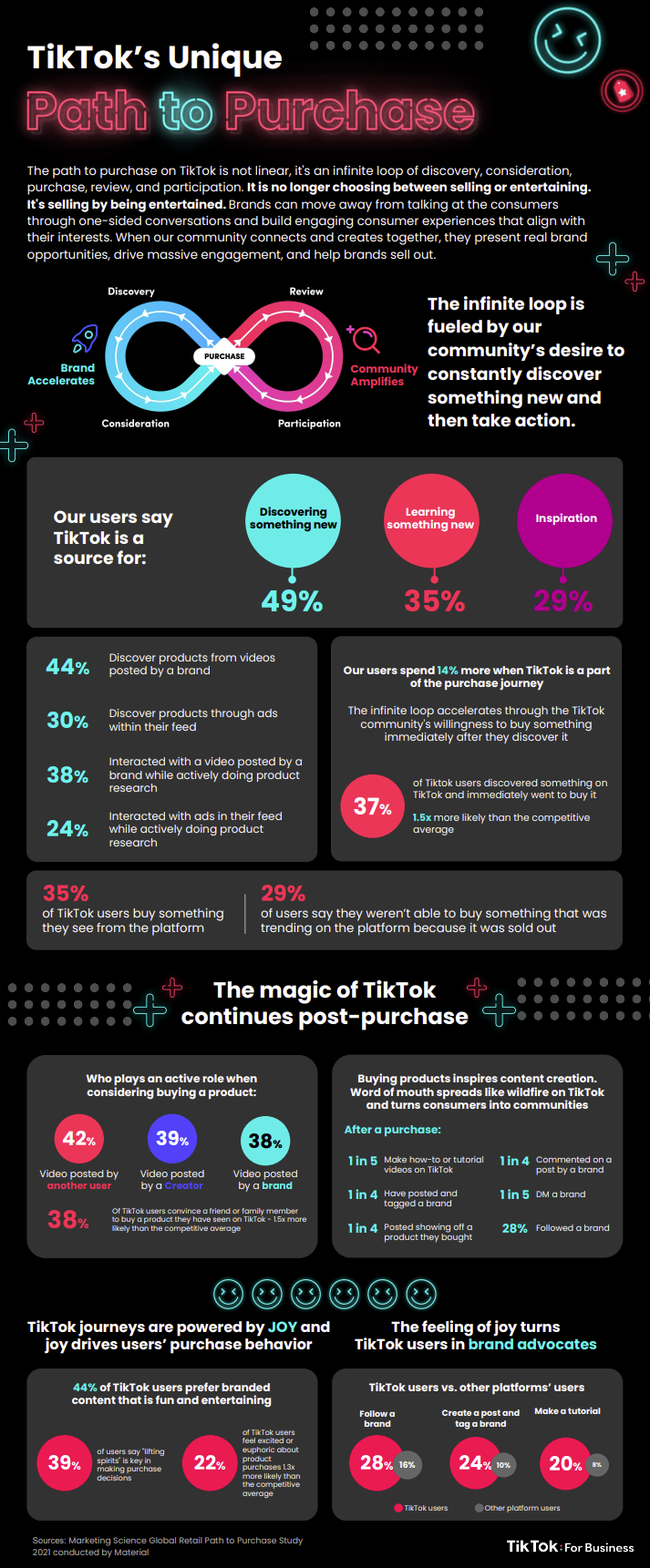
Emmanuel Fonte | Music | Art | Leadership
If music be the food of love, play on. Emmanuel Fonte website is about music, art, real estate, architecture, design and decor. Occasionally, I talk about my other passion, hockey.
TikTok has published a new report which provides fresh insights into the role that its platform plays in the evolving path to purchase, and how TikTok clips can change the way that brands and consumers interact.

Are you just getting started with a Google Ads campaign for your business? Need help creating your ads and deciding on the right way forward?
The team from Red Website Design share 8 free Google Ads tools to try in this infographic.


To be successful, a marketing strategy needs to be carefully thought out and meticulously planned. Creating a winning marketing strategy is always tricky. However, if you manage to get things right, it will help your business grow and expand. Rather than recommending general and vague approaches, we will discuss six ways to add more meaning and purpose to your marketing strategy.
You’ll need to have a good idea of what you want to achieve with your marketing. Some of the most common answers usually revolve around selling more products. However, modern brands have a complex relationship with the internet, and marketing can be used for much more than simply moving products. Focusing only on sales can actually alienate some of your audience. Instead, you can look for ways to add more meaning and purpose to your marketing strategy while adopting a more humane approach.
Other goals you can achieve through your marketing strategy:
Although it may sound trivial, it’s important to figure out what you want to achieve through your marketing. The goals for a marketing strategy for selling a home will be quite different from marketing for an eCommerce store.

The internet is a large place, and there is an insane amount of data being generated every 60 seconds. Even if you try to look at just the data your marketing can produce, it will still be very easy to get overwhelmed by the sheer volume of information.
Realistically, not all the data you gather will be relevant. You’ll need to eliminate the needless information and get rid of as much noise as you can to focus on what’s really important, and your choice of metrics can help you there.
You can ask members from various departments which Key Performance Indicators are essential to them. However, you should also include customer feedback so that you can add more meaning and purpose to your marketing strategy.
When trying to create a marketing strategy, it’s crucial to know who you will be marketing to. Defining your target market doesn’t mean you need to market to only one audience, but you should still know which demographics your users fall into.
If you are marketing a single product to multiple different demographics, you should make small adjustments to better resonate with those audiences. It’s also important to note where those audiences reside on the internet and customize your marketing to better fit the trends on those platforms. Social media can have an enormous impact on audience behavior, and it can also influence what kind of content will get more shares and likes.
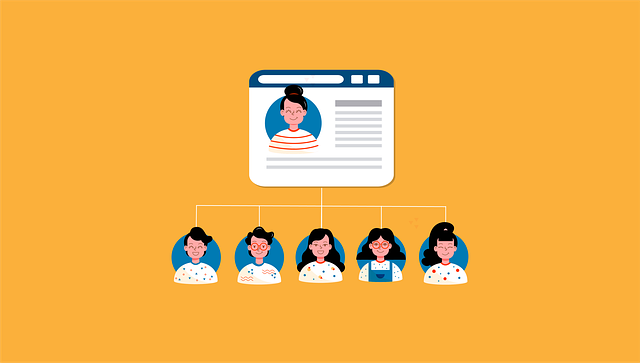
For the longest time, content creation was viewed separately from marketing. On the other hand, nowadays, you simply can’t avoid industry buzzwords like content marketing.
Intermixing engaging content with your other promotional marketing can make your entire marketing strategy come off as more appealing to a wider audience. If you are struggling to find the right balance of content and promotional ads, you can follow the 80-20 rule. This means that 80 percent of your marketing needs to offer genuine value to your users.
However, you’ll also need to create a plan to distribute the content out to your audience. You don’t have to limit yourself to only one channel or platform. On the other hand, you can also hide some of your content behind a subscription, which can be a great way to get a hold of user emails and generate leads.
Connecting to your local community is one of the best ways to add more meaning and purpose to your marketing strategy. You should get to know the people in your area and start building solid relationships with the people in your community. This can include both customers and other local businesses.
Support local events, or even host your own, and try to be present whenever something important is happening. This will give your marketing a hands-on approach, and your brand will become a common household name.
When it comes to the SEO side of things, you can try out some of the following:

Some business owners may fear that marketing automation can make their company feel impersonal. On the contrary, if you automate some of the processes that are more mundane, you will have more time to focus on your leads and build stronger relationships with your customers. Your marketing will also be much more efficient, and employees will have an easier time sharing information across teams. Automation is also scalable, so you will be able to find the perfect balance for your business.
Marketing can make or break any business, and if you play your cards right, you’ll be able to win over a loyal following, increase sales, and boost your brand’s reputation. A good solution to ensure your marketing stays on track is implementing these six ways to add more meaning and purpose to your marketing strategy. By following our tips, you will be able to achieve success and set up your business for long-term stability.
Meta description: Your company’s marketing needs to be able to achieve multiple goals. Here are 6 ways to add more meaning and purpose to your marketing strategy.
Images used:
https://unsplash.com/photos/8wH1NjFthaY
https://www.pexels.com/photo/white-printer-paper-on-brown-wooden-table-7413936/
https://pixabay.com/illustrations/buyer-persona-business-dental-clinic-6231739/
Meta description: From de-cluttered workflows and outreach fueled by event triggers to less human error, discover how marketing automation can help your business grow.
One might argue that since digital marketing’s inception, automation has lied in its heart. Automating repetitive tasks had seemingly always seen use in digital spaces, so applying the concept to marketing only served as a natural evolution. Today, marketing automation can help your business grow and thrive, enhancing multiple different practices in fundamental ways. To illustrate, let us devote this article to exploring its forms and just how it can do so.
At its core, marketing automation is a simple enough concept. It is the automation of repetitive marketing tasks that require little to no creative oversight. This is typically achieved through dedicated third-party automation software, although social media, CMSs and their plugins, and other platforms and assets may also provide such options.
Today, marketing automation boasts tremendous popularity, as 51% of all companies are already using it. In turn, the marketing automation software market experiences substantial growth, with Statista predicting it will “grow at a CAGR of 19.2 percent between 2020 and 2025”. In numbers, the industry’s 2019 $6 billion size seems set to almost triple by 2025. Even as regards B2B specifically, despite its unique challenges, forecasts remain very consistent with Statista’s:
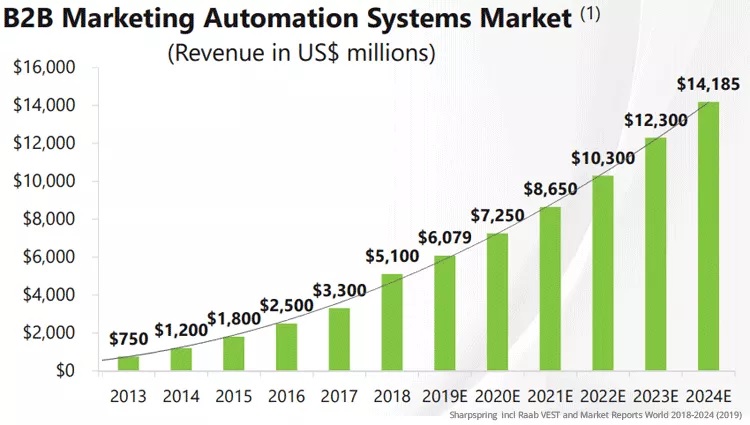
Alt-tag: A graph on B2B marketing automation systems market’s expected growth.
Marketing is a very broad field, however. In turn, marketing automation can help your business grow through multiple different applications, depending on your specific goals and needs. Three of the most notable use cases for it are the following.
Email marketing remains a powerful digital marketing mainstay, with excellent Return on Investment (ROI). Email also remains the primary communication tool of most businesses, so automation could only expand to meet its needs.
Email marketing automation offers to automate emails based on customizable event triggers. Such triggers may include actions taken, lead status, segment-based scheduling, and more. These offer unparalleled convenience and demonstrable benefits, as we will cover next.
Another prominent marketing channel lies in social media. Expanding platforms offered marketers access to vast untapped audiences and still serve as the primary brand awareness generators for many.
Still, social media is an inherently challenging marketing front, as audiences increasingly value authentic engagement over hard-sell outreach. In this regard, automation seeks to both streamline the process and prevent problems on social media, avoiding mistakes such as inconsistent schedules and suboptimal audience insights collection..
Finally, as companies increasingly value customer interaction quality, CRM emerged as a series of practices seeking to ensure it. This gave rise to dedicated CRM software, whose most basic features now include automation of focus-specific types.
Reflecting the overall growth of automation software, CRM is now the single largest software market in the world. Forecasts also outline a continued upward trajectory, at that:
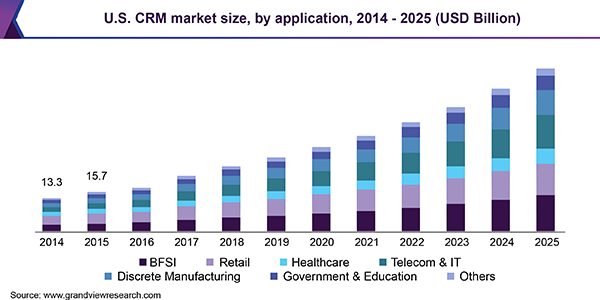
Alt-tag: A graph on the expected growth of the CRM market size in the US.
Source: https://www.grandviewresearch.com/static/img/research/us-crm-market.png
With all of the above in mind, we may now pinpoint exact benefits of marketing automation across different applications. For the sake of text economy, we will focus on 4 among the most notable ones.
Among the primary concerns of any business come lead concerns. Even the most robust lead generation, acquisition, and conversion systems may have room for improvement, which directly translates to revenue.
In this regard, automation offers distinct benefits for each phase:
This may be the most substantial way in which marketing automation can help your business grow, all in all. Indeed, most marketers prioritize lead-related improvements over most else:
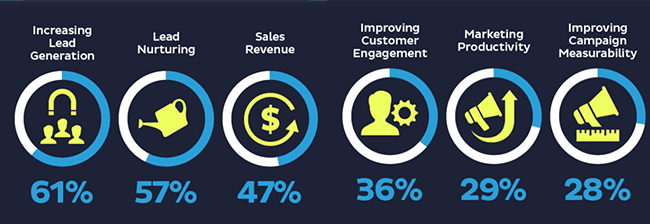
Alt-tag: An infographic on marketers’ most coveted benefits of marketing automation.
Source: https://startupbonsai.com/wp-content/uploads/2020/01/Statistic-7-Marketing-Automation-Statistics.png
Similarly, omni-channel marketing presents immense opportunities – and considerable challenges. Marketers have to focus on different content distribution channels as their companies expand to meet customers’ expectations.
Marketing automation rises to the challenge, in many cases directly evolving to do so. Its benefits in this regard can expand to, among others:
Of course, exact automation applications will vary depending on each marketer’s scope and existing assets. However, as the ongoing pandemic continues to fragment customer journeys, omni-channel marketing should remain a prominent approach.
Another inherent benefit of marketing automation lies in more streamlined workflows. In turn, automatic data entry and trigger-dependent outreach can minimize the room for human error, which remains a performance inhibitor.
Examples of workflows one may automate and streamline include:
In all such cases, automation offers to circumvent human involvement until creative input is needed – thus reducing human error. Of course, each workflow automation type will differ, but they will all follow a similar trigger-based structure:
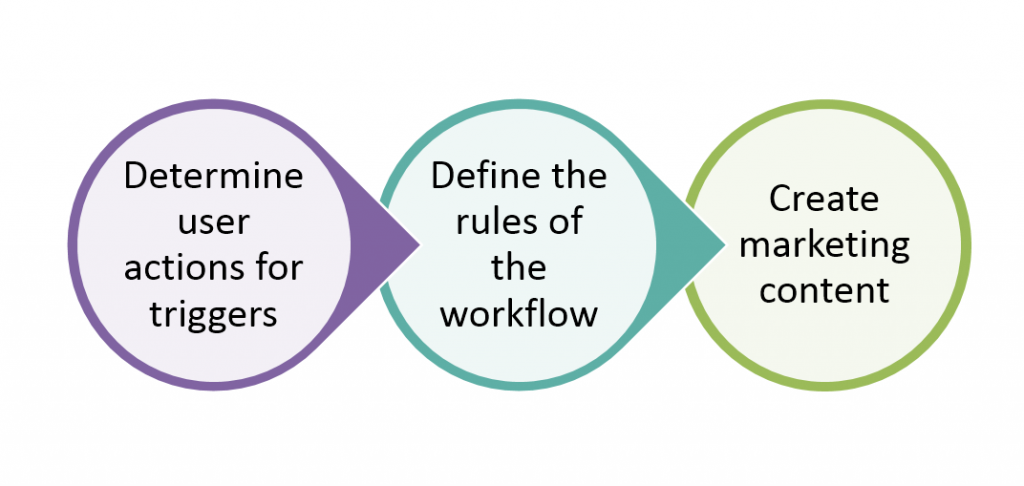
Alt-tag: An illustration of the typical workflow automation structure.
Source: https://blog-assets.freshworks.com/freshsales-crm/wp-content/uploads/2021/03/23131733/triggers-3-1024×486-1.png
Finally, another inherent benefit of marketing automation comes in the form of better time management and enhanced productivity. Jared Atchison, the co-founder of WPForms, expresses this in the simple truism that “[p]utting energy into smaller tasks […] wastes valuable time you could spend maximizing profit and nurturing leads”.
Automation’s productivity benefits can notably include:
In combination, such benefits can have a massive effect on both final revenue and cost. Studies quantify the potential operational cost benefit as up to 30%, a substantial benefit to any business.
In summary, marketing automation can help your business grow in a plethora of ways. At its core, it offers unprecedented convenience and an invaluable time management asset. Problem-solving applications may manifest these qualities in personalized outreach, more efficient lead nurturing, enhanced internal communications, and more. As such, as digital marketing expands to more channels and faces new challenges, automation will likely remain an indispensable asset.

source: https://www.websitebuilderexpert.com/designing-websites/how-to-choose-color-for-your-website/
Engaging visuals are key to standing out in busy social media feeds, and as such, it’s worth taking note of trend listings like this and considering whether you need to update your brand style and format.

Here’s a guest post from Mary Aspen Richardson.
Despite your best efforts, from marketing to sales to post-sale engagement, you will inevitably lose leads. Most new leads will simply never convert, regardless of how much a powerful marketing funnel will help the odds. Many existing leads will eventually fall off, and it’s indeed important to know when to give up. However, some old leads will convert with proper re-engagement outreach, and it might be too valuable for you not to try. For those cases, we have gathered six tips to re-engage old sales leads, dividing each between dos and don’ts.
First, let’s briefly discuss why old sales leads get lost in the first place.
Research suggests much of the fault lies with marketing teams and sales representatives. Initially, Hubspot cites research that suggests lead nurturing is still distinctly lacking, especially for B2B businesses. Among other statistics, they report that:
This already paints a bleak picture. Undoubtedly, new and old leads alike will slip through the cracks if lead nurturing is not present. Indeed, MarketingDonut research confirms this, finding that “80% of non-routine sales occur only after at least five follow-ups”. However, sales reps give up way sooner:
Granted, they have the reputation of being “pushy” to compete with – as we’ll discuss below. However, there seems to be room for considerable improvement between the proper implementation of lead scoring and outreach insistence.
So, how exactly can you re-engage old sales leads effectively? After proper branding efforts, which will make your leads more susceptible to re-engagement, you may consider the following six factors.
The fundamental first step lies in personalization, from copy to timing. Re-engaging leads with the blanket, soulless copy at random times will not suffice, as it doesn’t for traditional marketing. Thus, you should begin by leveraging each lead’s data – ideally gathered through Customer Relationship Management (CRM) software.
In this regard, CRM is tailor-made for personalization and automation alike – as we’ll cover later. So, CRM can be your ally in this effort. Use its lead management features and leverage all the data it offers to re-engage old sales leads. There’s a reason why it’s currently the most prominent software market in the world, according to Statista:

Alt. tag: A graph on Customer Relationship Management software market revenues worldwide from 2015 to 2024.
Source: https://www.statista.com/statistics/605933/worldwide-customer-relationship-management-market-forecast/
However, CRM’s database is only as accurate as you allow it to be. To avoid needless clutter, consider regularly scrubbing your database of invalid email addresses, definitively dead leads, and other outdated data. Coupled with good lead nurturing, this will help you focus your efforts.
Next, having touched on emails, they are likely the very first option for re-engagement. Still, the fact they work does not mean they will work without proper care.
Email is indeed one of the best ways to reach out to old leads. After all, they have opted to receive emails, so they’re more likely to open them and act on them. Moreover, emails offer room for considerable personalization, from subject lines to copy and timing. Thus, email is an excellent channel through which to re-engage.
However, even with personalization in place, you should still opt for simplicity, clarity, and brevity. Baydin research finds that the average user receives 147 emails a day and spends over 2 ½ hours on them. To ensure old leads engage with your emails at all, you should ensure they’re short, sweet, and to the point.
Another channel to consider, whether email outreach has failed or not, is social media. This channel, too, warrants examination.
First, social media are indeed a demonstrably effective channel to re-engage old sales leads through. Such platforms as Instagram offer notable engagement rates, and social media outreach is often perceived as less intrusive. Should your lead data suggest there are opportunities in social media, you should act on them.
That’s not to say, however, that you should do so indiscriminately or relentlessly. Responding to your audiences’ messages and posts or reaching out yourself can be effective, but there is a fine line. Where it is exactly will, of course, depend on your own data, but you should mind the “pushy” label. According to SproutSocial’s data, audiences definitely do:

Alt. tag: Statistics on “actions that make people unfollow a brand on social media”.
Source: https://media.sproutsocial.com/uploads/2018/10/graph-unfollow-actions-1.png
Next comes automation. This handy practice offers unquestionable efficiency, especially if you’re addressing vast numbers of leads you can’t manage manually.
To address the efficiency aspect, consider how CRM-backed automation can enhance your efforts through:
Through these benefits and others, automation can offer a tremendous asset.
Blanket automation can do more harm than good. Consider all of the statistics cited thus far; a lack of personalization will, in most likelihood, fail. Instead, consider custom event triggers for different lead segments and have your data inform your actions.
Now, having touched on personalization manifold, we may discuss re-engagement copy. Based on each lead’s history and status, this is where your re-engagement efforts will succeed or fail.
Keeping outreach timing and overall copy simplicity in mind, you should strive to earn your leads’ interest. To do so, consider offering your leads any of the following, among others:
That said, going for a hard-sell message will most often, if not always, fail to re-engage old sales leads. Instead, you may go for softer warm-up outreach, offering proverbial gifts like the above. That’s because there is the dreaded aforementioned “pushy” label to avoid at all costs, as Hubspot notes:

Alt. tag: A graph on the perceptions of sales reps and buyers on their experiences with sales outreach.
Source: https://www.saleshacker.com/wp-content/uploads/2019/02/lead-re-engagement-content-image.png
Finally, copy aside, there is also your outreach style to keep in mind. Here, too, we may consolidate all of the above into a simple pair of suggestions.
First, your outreach should, generally, remain professional. Consider a traditional email format for personal outreach and professional copy style for product updates. Still, your lead data may suggest you can try more casual styles to better effect. Thus, don’t be afraid to personalize your style depending on your data.
That said, however, you should, in most cases, avoid becoming too casual. Regardless of your lead’s status, you will most likely fail to re-engage them if you’re approaching them without due decorum. Avoid emojis, slang, and other inappropriately casual elements – unless your data explicitly suggest that you should use them.
To summarize, it’s no easy endeavor to re-engage old sales leads. First, you should ensure you leverage as much lead data as possible to facilitate proper personalization. Then, you should use email, social media, and other platforms wisely and in accord with your data. Finally, it would be best to employ automation in equally data-driven ways and carefully examine your copy and style to refine your outreach. In all cases, you should strive to avoid salesy language from the start and instead approach leads with helpful intent. In doing so, you may avoid the “pushy” label and instead offer meaningful outreach that attracts leads back.
Mobile usage is now a key connector, in an increasing range of ways, and providing an optimized, engaging mobile experience is key to maximizing your business performance.

Contract signings climbed 7.5% in October, and home sales for 2021 are on pace to hit a 15-year high, the National Association of REALTORS® reported Monday. Pending home sales rebounded after a decline in September.
Despite rising mortgage rates, home buyers appear undeterred by higher financing costs and home prices. Contract activity increased month over month in all four major regions of the U.S. NAR’s Pending Home Sales Index is a forward-looking indicator of home sales based on contract signings.
“Motivated by fast-rising rents and the anticipated increase in mortgage rates, consumers that are on strong financial footing are signing contracts to purchase a home sooner rather than later,” says Lawrence Yun, NAR’s chief economist. “This solid buying is a testament to demand still being relatively high, as it is occurring during a time when inventory is still markedly low.”
Yun notes that the gain in October assures that total existing-home sales in 2021 will exceed 6 million. That will mark the top performance in home sales in 15 years, Yun says.
He does forecast, however, home prices will increase at a “gentler pace” over the next several months and expects demand to be milder as mortgage rates increase. The 30-year fixed-rate mortgage averaged 3.10% last week, up from a 2.72% average a year ago, Freddie Mac reports.
Last month, contract signings increased at the strongest pace in the Midwest and South regions. The Northeast increased 6.9% in October, but contract signings are still down 10% from a year ago. The Midwest saw contract signings climb 11.8% in October; pending home sales are up 5.1% from a year ago.
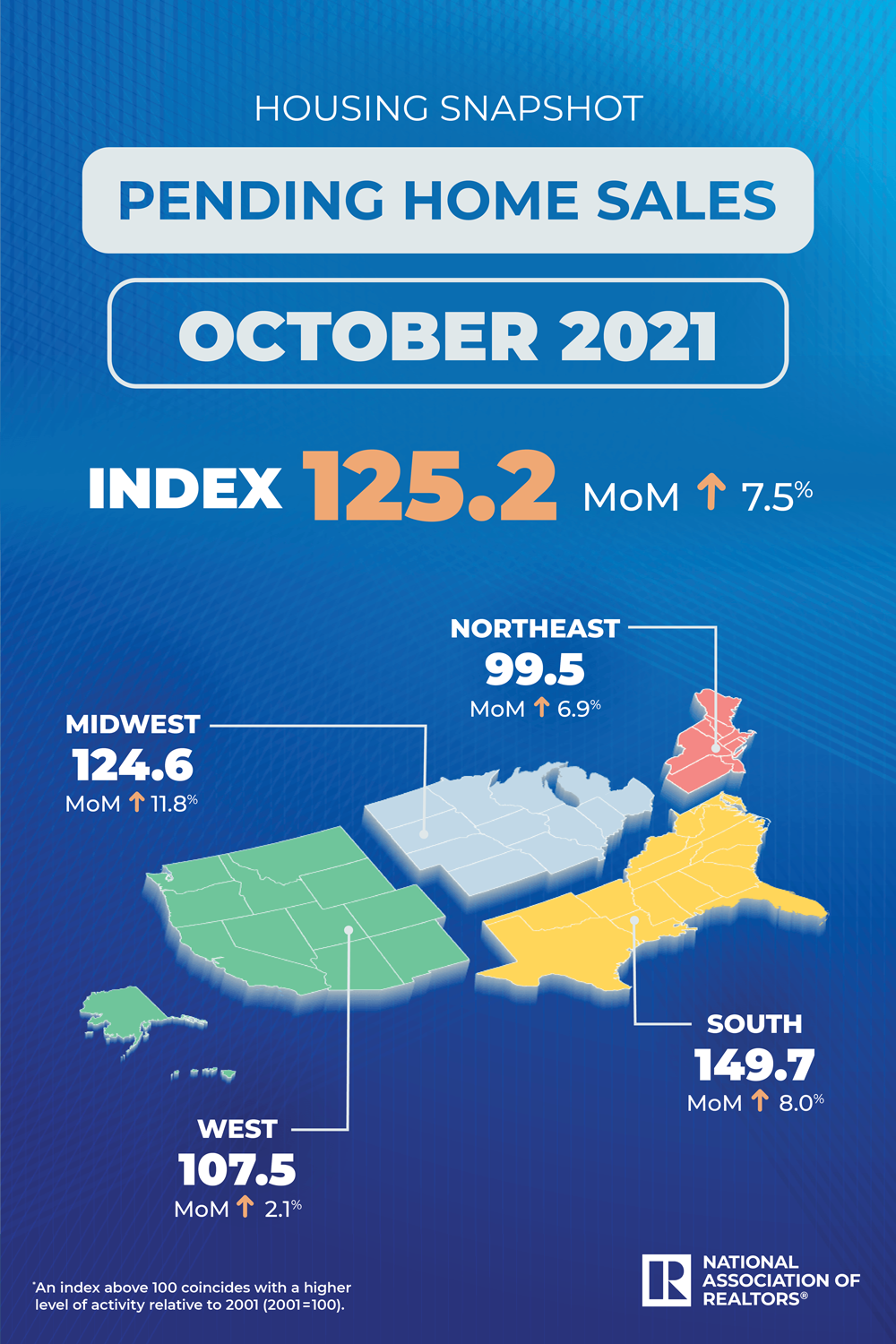
According to a recent CMO Survey, social media became even more critical to marketers during the pandemic, with those that were able to get their social media efforts right seeing major return on their social media investments.
It’s clear that social media will continue to play a crucial role in driving customers, especially in the post-pandemic world – and as such, marketing leaders need to plan their social media marketing strategies accordingly.

Copyright © 2016-2024All Rights Reserved
Powered by Wordpress Web Design on the Genesis Framework